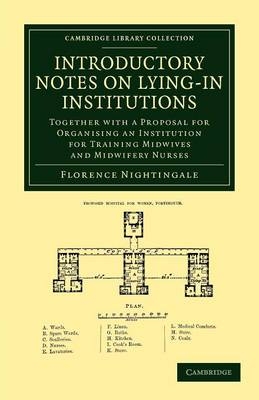
Introductory Notes on Lying-In Institutions
Together with a Proposal for Organising an Institution for Training Midwives and Midwifery Nurses
Seiten
2012
Cambridge University Press (Verlag)
978-1-108-05319-8 (ISBN)
Cambridge University Press (Verlag)
978-1-108-05319-8 (ISBN)
By the late nineteenth century, it was still safer for a woman to give birth at home than in a maternity hospital. In this book, first published in 1871, Florence Nightingale (1820–1910) provides a detailed statistical analysis of the problem, including her conclusions and recommendations for improvement.
The greatest postnatal killer of the nineteenth century was puerperal fever. A vicious and usually fatal form of septicaemia, puerperal or childbed fever was known to occur in maternity hospitals far more frequently than at home births, and to spread faster in crowded wards than in those with fewer patients. Its cause was unknown. In this precise statistical analysis of the facts, gathered from several sources across the major cities of Europe, Florence Nightingale (1820–1910) explores the mystery of puerperal fever and its possible causes. She stresses the necessity of good ventilation in hospitals, condemning those with overcrowded wards, and cites instances where the layout of wards has a noticeable correlation with the number of deaths. Published in 1871, just before Pasteur's work on germ theory proved that the problem could be all but eradicated if doctors washed their hands more rigorously, this work remains clear, scholarly and engaging.
The greatest postnatal killer of the nineteenth century was puerperal fever. A vicious and usually fatal form of septicaemia, puerperal or childbed fever was known to occur in maternity hospitals far more frequently than at home births, and to spread faster in crowded wards than in those with fewer patients. Its cause was unknown. In this precise statistical analysis of the facts, gathered from several sources across the major cities of Europe, Florence Nightingale (1820–1910) explores the mystery of puerperal fever and its possible causes. She stresses the necessity of good ventilation in hospitals, condemning those with overcrowded wards, and cites instances where the layout of wards has a noticeable correlation with the number of deaths. Published in 1871, just before Pasteur's work on germ theory proved that the problem could be all but eradicated if doctors washed their hands more rigorously, this work remains clear, scholarly and engaging.
Preface; 1. Midwifery statistics; 2. Construction and management of a lying-in institution and training school for midwives and midwifery nurses; Appendix.
| Reihe/Serie | Cambridge Library Collection - History of Medicine |
|---|---|
| Zusatzinfo | 8 Line drawings, unspecified |
| Verlagsort | Cambridge |
| Sprache | englisch |
| Maße | 140 x 216 mm |
| Gewicht | 190 g |
| Themenwelt | Medizin / Pharmazie ► Gesundheitsfachberufe ► Hebamme / Entbindungspfleger |
| Studium ► Querschnittsbereiche ► Geschichte / Ethik der Medizin | |
| ISBN-10 | 1-108-05319-X / 110805319X |
| ISBN-13 | 978-1-108-05319-8 / 9781108053198 |
| Zustand | Neuware |
| Haben Sie eine Frage zum Produkt? |
Mehr entdecken
aus dem Bereich
aus dem Bereich
Die Geschichte eines Weltzentrums der Medizin von 1710 bis zur …
Buch | Softcover (2021)
Lehmanns Media (Verlag)
CHF 27,90
Krankheitslehren, Irrwege, Behandlungsformen
Buch | Softcover (2024)
C.H.Beck (Verlag)
CHF 55,90


